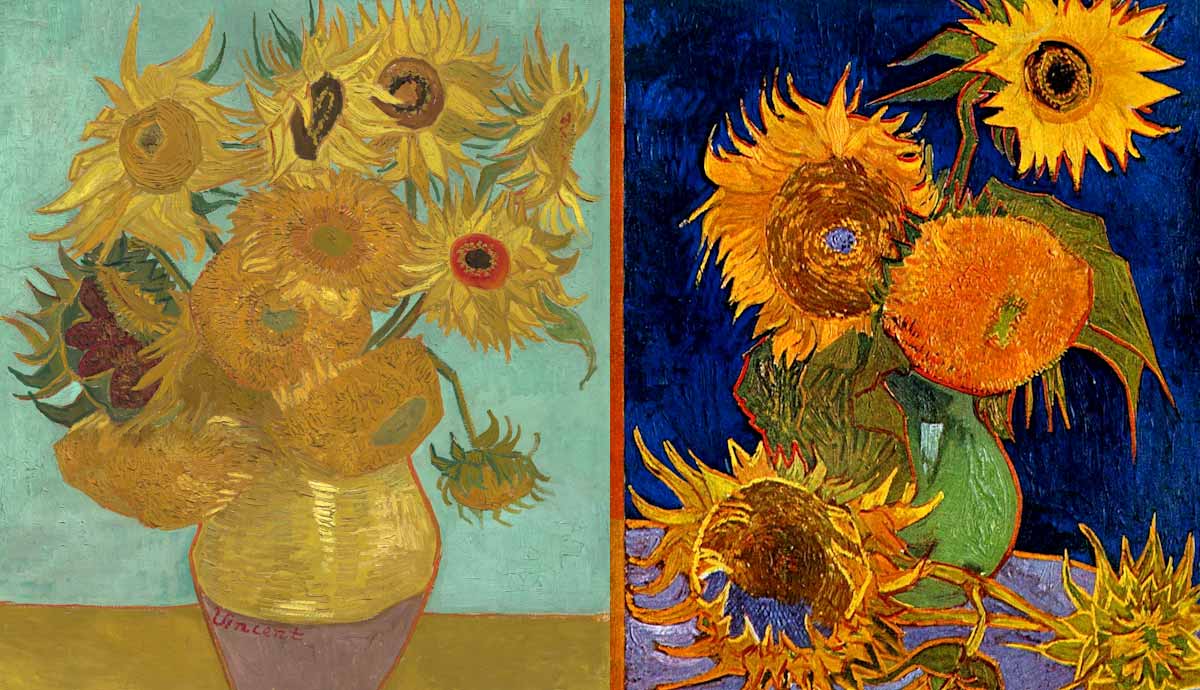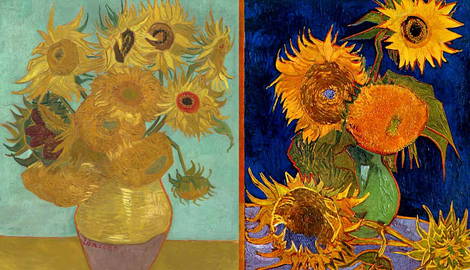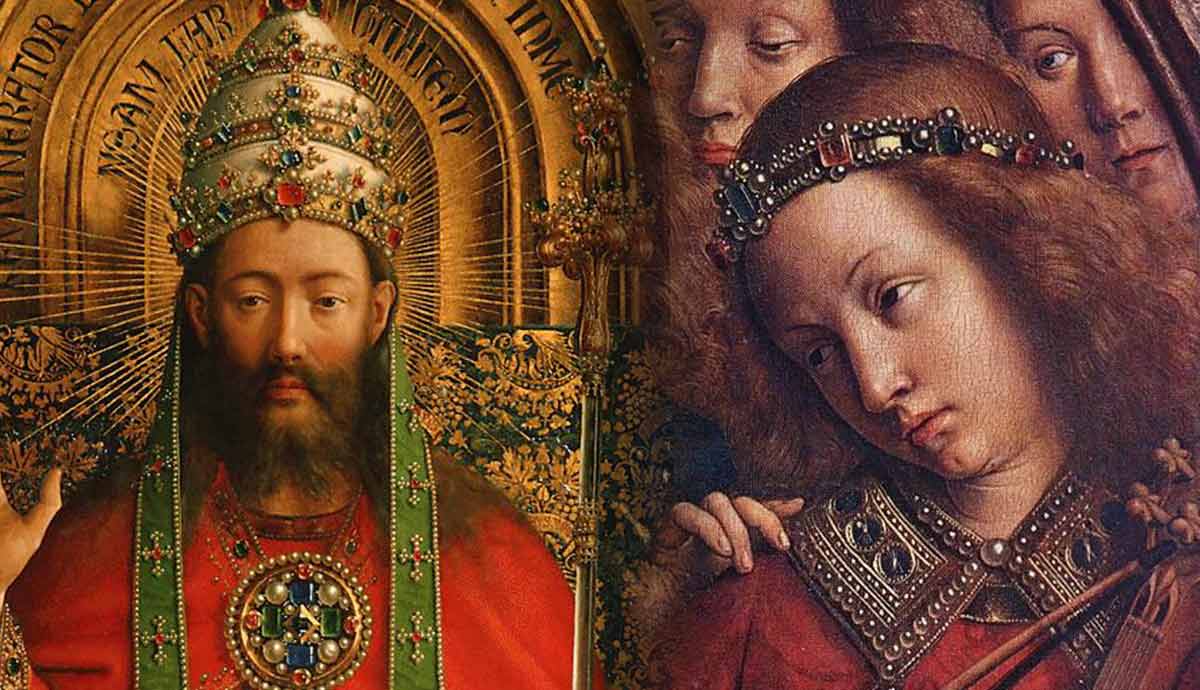
summary
- Between 1887 and 1889, the Dutch post-impressionist painter Vincent van Gogh created a significant series of paintings of sunflowers after encountering them on Japanese woodcut prints.
- He first painted them growing in situ on Montmartre hill in Paris in 1887, before producing four paintings of cut sunflowers in Paris in the summer of 1887.
- When Van Gogh went to Arles in 1888, he moved on to a series of seven still life paintings of sunflowers in vases.
- He chose some of his sunflowers to appear in the Berceuse triptych, bookending his portrait of Augustine Roulin. Van Gogh said that he imagined his Sunflowers as torches lighting many of his other works.
Van Gogh’s Sunflowers are some of his most famous and recognizable works, but many people don’t realize they belong to a sizable series of paintings. From 1887 to 1889, Dutch post-impressionist painter Vincent van Gogh (1853-1890) created 11 still-life paintings of sunflowers after encountering the flower on Japanese woodblock prints. Van Gogh first painted the flowers in Paris, then continued exploring the theme when he moved to Arles in 1888. He also incorporated his favorite blossoms into a number of his other artworks and considered how his sunflowers complemented his other pieces.
1. The Painter of Sunflowers, Paul Gauguin, 1888

For Van Gogh, sunflowers represented gratitude. His fascination reflected his hopeful and optimistic side as a painter. Vincent van Gogh wanted to be known as the “painter of sunflowers,” a distinction his legacy has earned him today.
However, while The Painter of Sunflowers (1888) is first on our list, it was not painted by Vincent van Gogh but by his roommate and fellow artist Paul Gauguin, who captured van Gogh painting his beloved sunflowers. The Dutch post-impressionist painter lived with Gauguin in a rented house known as the Yellow House in Arles, France, in 1888, before an intense altercation in December of that year in which Van Gogh severed his own ear. This event prompted Gaugin to move out and return to Paris.
2. Two Cut Sunflowers, Paris, 1887 (F375)

Though much of Van Gogh’s love affair with sunflowers occurred in Arles, he first started painting the blooms in Paris in 1887. His initial approach to the flower was different from what he is now known for, as he depicted them cut and withering as opposed to blooming in a vase. Two Cut Sunflowers (1887) is one of Van Gogh’s first paintings featuring sunflowers, from a series of four still life paintings created that year. Paul Gauguin took a liking to this particular painting and kept it above the bed in his Paris apartment for many years.

Van Gogh titles most of his sunflower paintings simply Sunflowers, which means that it is not always easy to distinguish between them. Alternative names, such as Two Cut Sunflowers, were added later to help distinguish between them. To clearly identify the paintings, we often use catalogue numbers assigned by Jacob-Baat de la Faille in his catalogue of Van Gogh’s work. For example, the first painting depicted is F375, while the one below is F376, also painted by Van Gogh in Paris and then in the possession of Gauguin. In the mid-1890s, Gauguin sold both paintings to fund his South Seas trip.
3. Sunflowers Gone to Seed, Paris, 1887 (F377)

Sunflowers Gone to Seed (1887) was yet another of Van Gogh’s Paris sunflower paintings, again as cut and trimmed flowers. This piece was left by Van Gogh at the Paris apartment of his brother Theo van Gogh between mid-August and mid-September 1887. This work is particularly striking in its use of a green background and the withered state of the sunflowers in the painting.
4. Four Sunflowers Gone to Seed, Paris, 1887 (F452)

Often described as an unusual still life, Four Sunflowers Gone to Seed (1887) is one more of Van Gogh’s Paris sunflower portraits. The flowers in this one, again cut, take up much of the canvas and are life-sized. Van Gogh uses a multicolored backdrop without distracting from the main subject. This work is remarkable in that the flowers exist in an almost liminal space, allowing them to draw focus in a simple environment.
5. Three Sunflowers in a Vase, Arles, 1888 (F453)

The first of Van Gogh’s iconic paintings created in Arles is Three Sunflowers in a Vase (1888). It shows a stunning and vibrant turn from the cut and withered blooms he depicted in Paris. Painted in the post-impressionist style, this work depicts three bright yellow sunflowers in a green vase against a turquoise background. While the backdrops in his Paris paintings were free of distraction, the teal wall behind the flowers provides great contrast and further brightens the atmosphere of the painting.
6. Vase with Six Sunflowers, Arles, 1888 (F459)

The second iteration of sunflowers in a vase Van Gogh painted was Vase with Five Sunflowers (1888). This painting also has high color contrast, but for different reasons than the bright and sunny Three Sunflowers in a Vase (1888). In this work, the sunflowers are still vibrant, but also jagged and falling from the vase. The deep blue background provides a more intense contrast to the flowers, making them pop at the center of the work. This painting was sadly destroyed in 1945 in Ashiya, Japan, where it resided in a private collection, when a US World War II Air Raid caused a fire.
7. Vase with Twelve Sunflowers, Arles, 1888 (F456)

This third version of Van Gogh’s Arles sunflowers, Vase with Twelve Sunflowers (1888), was originally painted to be hung in his shared studio with Paul Gauguin. With a similar color palette to the first version, this painting shows the sunflowers in a greater number but in a less vibrant state. This is an important addition to Van Gogh’s Sunflowers because it was one of the canvases he selected to be paired with his painting La Berceuse (1889) to form a triptych.
8. Vase with Twelve Sunflowers, Arles, 1888 (F455)

In the winter of 1889 in Arles, van Gogh created copies of some of his favorite sunflower paintings, including a third version of Vase with Twelve Sunflowers (1888). Though his duplicates are similar to their original counterparts, he painted these new works from memory, so there are slight idiosyncrasies and differences from the first version.
9. Vase with Fifteen Sunflowers, Arles, 1888 (F454)

This fourth version of Sunflowers, or Vase with Fifteen Sunflowers (1888), is one of the most famous versions. It is renowned both for being a magnificent work favored by the artist and for the act of protest in 2022 when Just Stop Oil climate activists threw tomato soup over it while it was hanging in the National Gallery in London. Van Gogh made two copies of this painting in the winter of 1889 (F457 and F548), making it one of the more recognizable paintings from Arles. This fourth version is distinctive due to the lack of contrast in its color palette, with Van Gogh having mainly used shades of yellow with hints of blue and green to create a beautiful depiction of his favorite flower. The painting is the other version of Sunflowers that van Gogh selected to be part of the Berceuse Triptych.

Van Gogh regularly considered how the Sunflowers would pair with his larger body of paintings, and one idea he had for display was the Berceuse triptych. La Berceuse (Woman Rocking a Cradle; Augustine-Alix Pellicot Roulin) (1889) is another of Van Gogh’s paintings for which he created multiple copies. The work depicts Augustine Roulin, wife of Van Gogh’s friend Joseph Roulin, holding the rope attached to a cradle that is out of the frame. This work features flowers in the wallpaper background, but these are not sunflowers.

The Berceuse triptych is an arrangement Van Gogh created in 1889 featuring La Berceuse (1889) with the third and fourth versions of Sunflowers (1888) painted in Arles. In a letter to his brother Theo, Van Gogh described the triptych, saying the sunflowers would “form torches or candelabra beside the center painting.” He suggested that all the versions of La Berceuse and Sunflowers could be paired together this way, but selected these specific paintings to go together as a set known as The Berceuse Triptych (1888-1889).
10. Allotment with Sunflower, Paris, 1887

Though the cut sunflowers from Paris and sunflowers in vases from Arles make up the Sunflowers series properly, the flower held significant importance for Van Gogh and made appearances in peripheral works. Allotment with Sunflower (1887) is a still-life depicting a tall sunflower on the hill of Montmartre in Paris. Created before the main sunflower paintings, this work shows the sunflower growing from the ground instead of being cut or placed in a vase. For Van Gogh, these flowers represented gratitude, vitality, and the cycle of life, and as such, he painted them at their various life stages over the years.
11. Shed with Sunflowers, Paris, 1887

Shed with Sunflowers (1887) is yet another one of Van Gogh’s sunflower-related still-life paintings from Montmartre. Rather than centering the sunflowers in this one, he chose a wider scene view to show the site where his beloved blooms were growing. Although Van Gogh would become renowned as the painter of sunflowers, and his work related to the flower from Arles would become very famous, his journey with depicting the flower all started with an allotment garden on a hill in the summer of 1887.










